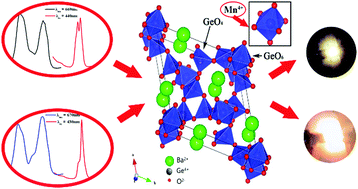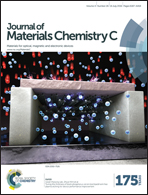Deep red MGe4O9:Mn4+ (M = Sr, Ba) phosphors: structure, luminescence properties and application in warm white light emitting diodes†
Abstract
In order to get efficient phosphors used in WLEDs to cover the shortage of red emission, highly saturated rare-earth-free red phosphors MGe4O9:Mn4+ (M = Sr, Ba) have been successfully fabricated by a solid state method at 1100 °C. The crystal structure properties including the phase purity were analyzed by means of X-ray powder diffraction (XRD), X-ray photoelectron spectroscopy (XPS) and transmission electron microscopy (TEM). Photoluminescence absolute quantum efficiencies as well as lifetimes were utilized to characterize samples. As for the photoluminescence properties, the excitation spectra of samples exhibit two broad absorption bands with peaks at about 300 nm and 430 nm, which could be excited by near-UV/blue LED excitation. The emission spectra exhibit sharp peaks ranging from 600 nm to 700 nm due to the 4Eg → 4A2g transition of Mn4+ ions. The optimal Mn4+ doping concentrations in both the SrGe4O9 and BaGe4O9 host are determined to be 0.5 mol%. The critical energy transfer distances of these phosphors are calculated to be about 19 Å, and the concentration quenching mechanism is proved to be the dipole–dipole interaction. With increasing temperature, the luminescence of MGe4O9:Mn4+ (M = Sr, Ba) phosphors gradually decreases and the BaGe4O9:Mn4+ sample with the quenching temperature (T0.5) of about 180 °C has better thermal stability than SrGe4O9:Mn4+ with T0.5 of about 100 °C. Based on a combination of a blue LED chip, YAG:Ce3+ and MGO:0.5%Mn4+ red phosphors, the warm WLED is fabricated to explore its possible application as a warm white light-emitting diode.


 Please wait while we load your content...
Please wait while we load your content...